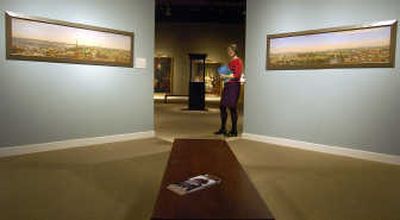Making history contemporary

Good museum curators must be part scientist, part detective, part teacher and part student. It also helps if they’re good at piecing together jigsaw puzzles. Marsha Rooney, senior curator of history for the Northwest Museum of Arts and Culture, possesses all these qualities.
“People think that history is written and put on a shelf,” she said. “But it isn’t. To me, a museum is filled with objects that all have a story to tell.”
Rooney moved to Spokane in 1986 and took the job of curator for the Campbell House two years later. In 1995 she accepted her current position.
Her passion for storytelling is what brings life and vibrancy to many exhibits at the MAC. For instance, Rooney’s idea behind the ongoing “Spokane Timeline: Personal Voices” exhibit was not only to tell the story of our city’s history chronologically, but to explore questions relevant to museum visitors. In the centerpiece of the exhibit, Rooney offers a glimpse of how Spokane became the medical capital of the Inland Empire. A collection of glass eyes, antique medical instruments and a prosthetic leg shows the progress of medicine in our region.
“The challenge for me is finding and putting things into the museum that build our collection and tell the best story of people in the region.”
On a recent afternoon she paused in front of a quilt made with colorful cigar-band ribbons. The yellowed quilt awakened her curiosity. Several ribbons bear the logo of a Spokane-based cigar factory. “It makes you wonder, doesn’t it?” she said. “You can’t just enjoy it. You want to know more,” which is why Rooney plans to research the history of cigar factories in Spokane for a future exhibit.
Rooney is responsible for creating what she calls the “menu” of historical exhibits for the MAC. She enjoys the complexity of her job. “I work with a great group of people,” she said. “And I love the subjects. I’ve learned not to take anything at face value. There’s a back-story to almost everything.”
This can be seen in the Olmstead Brothers exhibit. Rooney knew the 100th anniversary of their park plan would occur this year and started scouring the MAC’s collection for local ties to these famous brothers. She discovered that in addition to their design work for several Spokane parks, the Olmsteads did work for local families. She negotiated loans with the Washington State Archives, the National Archives and Records Administration and several private collectors to display stunning photos and drawings of the gardens belonging to prominent citizens like Louis Davenport, Aubrey White and Jay P. Graves.
Taking a national exhibit and adding a regional piece is what keeps Rooney’s job both interesting and challenging. The museum is the repository of thousands of items, and Rooney must keep tabs on many of them. The arrival of the Samuel Colt: Arms, Art and Invention exhibit prompted her to delve into the MAC’s collection of antique firearms. It proved to be a great excuse to display them. She also incorporated a video to demonstrate how firearms work.
Rooney seems to have near encyclopedic knowledge of the museum’s contents, but she shook her head and said, “I’m a facilitator. I’m not the one who knows everything.”
She likened her job to a detective looking for clues, putting them together – using her imagination to wonder what might have been. “I’m good at asking questions,” she said with a laugh. “I’m always discovering, always learning.”
For her, history isn’t found in dusty, dry tomes stacked on shelves. It’s found in quilts, letters, guns, photographs and even a collection of glass eyes. “History is more contemporary than you think,” she said. “Things change all the time.”
As she walked through the museum halls she greeted visitors warmly, like old friends. She said, “It’s the people’s museum, not just mine. This is a public trust.”